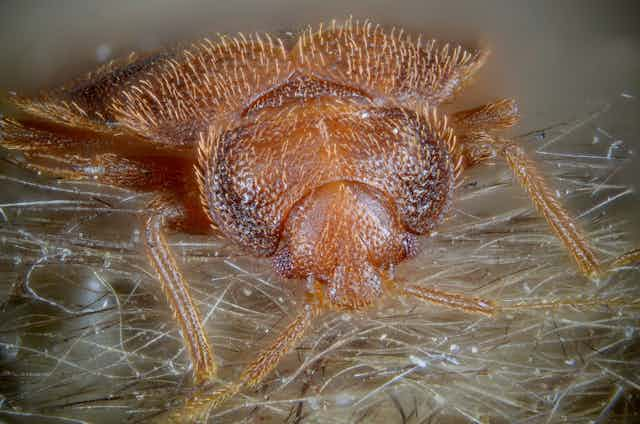Bedbugs have a lousy reputation at the best of times, but these unfortunate insects have taken a particularly firm kicking recently. An announcement that their genome had been sequenced was framed not as a remarkable scientific accomplishment but as useful information to help us humans destroy our enemies.
It’s not hard to see where the animosity comes from. Though bedbugs – known to scientists as Cimex lectularius – will feed on bats, chickens and domesticated animals, it is their taste for human blood that causes problems. After widespread DDT usage largely wiped them out in the mid-20th century they have made a strong return in recent years, with many becoming resistant to modern pesticides.
The bedbug problem is getting worse. Infestation horror stories have popped up in most major cities and a pest control team was even asked recently to exterminate bedbugs on an offshore oil rig.
We tend to associate bedbugs with dirty living conditions, but this is a myth – they don’t actually choose dirty homes over clean ones. Unusually for many blood-sucking insects, bed bugs haven’t (yet) been implicated in spreading disease to the humans they bite, so that’s one small thing in their favour, though they are suspected of carrying organisms that cause leprosy, oriental sore and the bacterial brucellosis, and may be able to transmit Chagas disease.
So can we defend these bugs, or is insecticide the only solution?
A bed bug for the prosecution
Bedbugs suck blood, which contains the DNA of people they fed on. Human DNA extracted from live, frozen and dried bedbugs has proven suitable for DNA profiling. Some scientists say we could therefore use the bugs as a source of evidence to prove a particular person had been in a bedroom.

Cimex are also wingless and don’t stay on their hosts after feeding. They tend to remain near the source of food though, so unlike other blood-feeders such as mosquitoes or black flies they can be present at a crime scene long after the perpetrator has fled.
An evolving species
Bedbugs are highly specialised for what they do. Like other Hemiptera (true bugs) their mouthparts are specially adapted to suck liquids, using needle like mandibles and maxillae to form hollow tubes, complete with pumps for saliva and suction. The saliva they inject prevents blood from clotting as they feed and in their gut, and their abdomens expand to allow them to feast on larger meals. All these features are a product of natural selection – and bedbugs are still changing, fast.
Then there is winglessness, which often evolves in species where flight is either too expensive in terms of energy, unnecessary in the absence of predators, or too risky in terms of living on a windy island. Many insects have short winged or wingless forms, but most of them have winged relatives, suggesting that once wings were present and functional. In fact, a close look at Cimex shows that it still has tiny front wings. Add to this host-seeking ability and rapid evolution of resistance to insecticides, and the bedbug becomes a useful model organism for scientific investigation.
Our need to understand a rapidly evolving species drove the complete bedbug genome sequencing. Among other things, scientists discovered the common bedbug split from those that feed on bats about a quarter of a million years ago, which means bedbugs predate modern humans by about 45,000 years. This may be an example of speciation in progress.
Our ancestors likely first associated with these nocturnal feeders while seeking shelter in caves. So bed bugs can tell us something about human history. They were certainly biting ancient Egyptians, and Roman scholar Pliny mentioned them in 77AD. It was the Romans who called them “Cimex”, which means bug, and they were recommended to treat ear infections and snake bites.

The genome research also shows how bedbugs have adapted to rely on a bacterial parasite called Wolbachia, that lives inside the bug’s guts and helps them conjure vital vitamins out of their blood only diet.
Thanks to bedbug research we now know a lot more about the genes that confer pesticide resistance, which may lead to new insecticides useful for the control of this and other species. Pests and pesticide resistance are in constant battle and a reminder of the resilience of species to survive.
An economic species
Bedbugs and other household pests could even be regarded as advantageous to the economy in that they keep people in work. More than 1,000 pest control companies provide employment in the UK alone, part of an annual market worth about £330m. Then there are the chemical firms manufacturing pesticides, companies that make vacuum cleaners, washing powders and (as a last resort) new mattresses.
So sleep tight, and if the bedbugs do bite, think about their contribution to forensic entomology, evolution and the economy.

